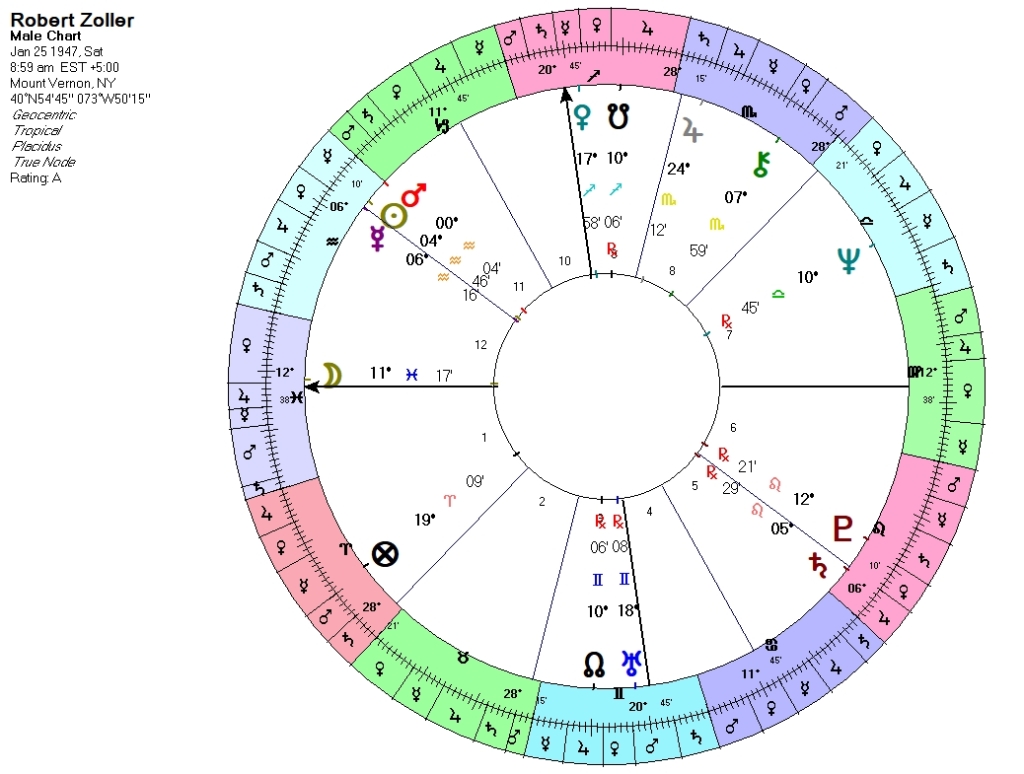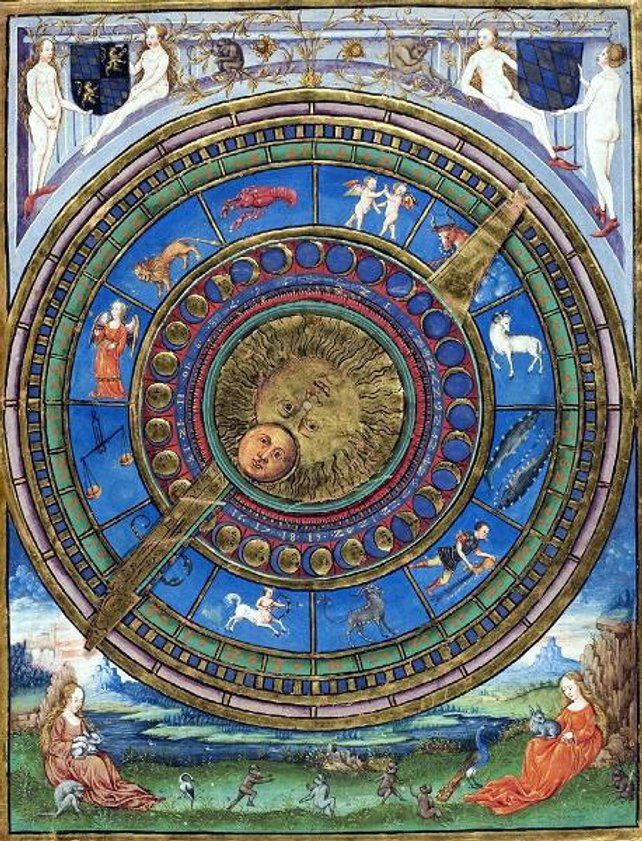Recently I participated in a discussion in an online forum about Robert Zoller’s use of the “modern” planets. This discussion grew out of comments made by Ben Dykes in a 2020 Astrology Podcast commemorating Robert Zoller in which Dykes stated that, as a student of Zoller, he was taught to remove outer planets and asteroids from his astrology charts and to use only the seven traditional planets:
“ ‘What am I really doing astrology for when I can’t rely on some of these things [the outer planets and asteroids] as crutches?’… ‘If I don’t have, let’s say, these outer planets or asteroids and if I’m taking things out of the chart and making it look cleaner and simpler, I’m starting to ask myself what kinds of explanations do I have for what’s happening in the chart?’ So we start to realize and reexamine, what are the tools that we have been relying on and how can we strengthen them and enrich them with traditional concepts, and also in a sense, cleanse ourselves of some addictions that we might have as astrologers. So having more points in the chart does not mean more wisdom, could be another way to put it. So he’s forcing you to rely on wisdom and deeper concepts instead of larding up the chart with points. That was one of the very first things that happened, and it was a really good education and way of reexamining how I thought about astrology.”
The characterization of the outer planets as “crutches” and “addictions” in the above comments, I believe, does not present a full picture of Zoller’s view or use of the modern planets, which clearly evolved over time. I first met Bob in the 1980s at an astrology conference and we spent time chatting about his interest in ancient Latin texts and his efforts to translate Bonatti. Bob was a student of Zoltan Mason in NYC, and it was Mason who introduced him to the work of Morin de Villefranche and encouraged him to read the traditional astrological texts in their original languages. Bob’s study of Morinus profoundly influenced his approach to delineating charts, and he endlessly repeated aphorisms from Morin’s tome, especially from Book 21.
Morinus, who had such a profound influence on Zoller’s thinking, discarded much of traditional astrology as superstitious nonsense. Morin rid his astrology of decans, faces, terms, traditional triplicity rulers (he developed his own system), profections (annual, monthly and daily), and the use of universal signifiers as particular indicators in charts. Zoller, in contrast, worked hard to retrieve and restore what Morinus had thrown in the garbage. Morin, of course, was unaware of the outer planets. Most likely he would have incorporated them into his astrology, probably in the same way he used fixed stars, if he found empirical evidence of their effectiveness.
Interestingly, Zoltan Mason, who was Bob’s teacher, regularly used the outer planets Uranus, Neptune and Pluto as co-rulers, respectively, of the signs Aquarius, Pisces and Scorpio. Zoller himself, in his 1981 book Tools and Techniques of the Medieval Astrologers, followed Mason’s lead and combined the use of both the traditional and the trans-Saturnian planets in his experimentation with medieval techniques, mostly those of Bonatti who had learned them from Latin translations of Abu Ma’Shar. Unfortunately, Bob had miscalculated the angles and cusps of his natal chart, which he used extensively in his experimentation with the medieval techniques. His Asc and MC in the 1981 text are almost a degree earlier than the correct values, so his predictions using primary directions are off by about 10 months.
In presenting the length of life technique described by Bonatti, Zoller concludes that his length of life. based on the seven traditional planets, is likely to be about 82 years, but because of the influence of Uranus, Neptune and Pluto in his chart, he would need to shorten it to 72 years. Bob was impressed that the 72 years, as calculated using both the traditional and modern planets, agreed with the length of life indicated by the method of William Benham in his book The Laws of Scientific Hand Analysis. In fact, Zoller died at age 72, just one day before his 73rd birthday anniversary. One has to wonder what role the power of suggestion played in his demise.

In his 1981 text, Zoller mistakenly cast the chart for Sullivan County, NY, which give an Ascendant of 11 Pisces 13′, and he used the incorrect earlier Ascendant degree in his calculation of continuous profections, thus introducing a timing error of about 10 months.
He regarded Pluto in the Placidus 6th house as being determined, as Morin would say, toward illness because of its placement in the 6th. He also stated that the profected Asc at age 2, being at 11 Taurus 13′ in his original calculation of his chart, was square to Pluto in the 6th, correlating with his serious illness just before he turned 2 years of age and his spending his 2nd birthday in an iron lung in the hospital. With the correct chart, the square of the profected ASC to natal Pluto at age 2 is even more exact.
Regarding Zoller’s evolving view of the use of the “modern planets,” Bob said the following in a 2006 interview with Garry Phillipson (italics mine):
“So, the bottom line is, you can do whatever you want to do, and you’ll probably do best following your own opinion and your own light. But my light on this situation in astrology, what I have tried to do, has been to give myself a firm foundation in medieval astrological techniques (which I see as being superior to either Greek or Babylonian astrology or to New-Age astrology) and then make whatever adaptations I feel I have to make to those techniques, such as the inclusion of the use of the modern planets.”


This topic raises a question:
Is astrology an interconnected cosmic system of all the stars and planets, or is it just a technique from which we select only a group of planets?
My personal opinion: Astrology is a cosmic system that includes the old and new planets together, and we need to conduct more research to find out how we are affected by this cosmic system.
Doctor, your words about the possibility of Zoller being influenced by the power of suggestion regarding the date of his death… This talk links astrology with quantum physics and parapsychology… and makes us wonder: Does the astrologer’s incorrect reading of clients lead to the activation of some judgments and affect the fate of the clients?
interesting article.
interesting article.
nice article anthony.. thanks… i was engaged by the comment “One has to wonder what role the power of suggestion…’ (- plays in astrology’).. it seems it plays a very large role.. i maintain so much of astrology is subjective in nature – much like art actually.. a good example was given in geoffrey cornelius’s book the moment of astrology where one is working with the wrong chart and yet the conclusions work.. i don’t have the details or page number, but aside from cornelius’s book being a great read – he highlights the divinatory nature of astrology..
i made a post at skyscript on the terms/bounds just the other day.. no one can explain the rationale for this system and just i read all sorts of justification for their use.. how much of that is a person using a particular system ( which morin threw out) and yet coming up with some insight that this system might have triggered in their intuition? how much of astrology is intuition? i don’t know, but i think it’s an interesting question and might explain why astrologers using various different approaches can still come up with valid insights, no matter what the basis is for their particular brand of astrology..
and ‘yet’ i read..
I knew Zoller very well (and also studied with him). Yes, he was focused primarily on the methods of the older astrologers prior to discovery of the outer planets. But I assure one and all that he was very aware of the outer planets and their power and influence. As for William Benham (palmist) and Zoller thinking his death at 72 would have been consistent with what Benham would have predicted, I did palmistry prior to studying astrology and read Benham’s work (though, admittedly, a very long time ago) and can remember nothing therein that would have allowed for such pinpoint accuracy as “72” (as opposed to 70, 71 or 73) RE Zoller’s exit. In fact, one of the reasons I got into astrology was because I expected it might have been potentially much more pinpoint in its predictive accuracy than “pure non-psychic” palmistry. RE the idea that the power of suggestion may have somehow influenced Bob to leave Earth a day before turning 73 so it could be consistent with what Benham might have predicted, I personally really doubt it.
Hi Jeff,
If you have Zoller’s 1981 book on Medieval Techniques, having calculated his length of life to be 82 years using medieval methods, on page 58 he writes about his own chart: “… the 82 year life span would be diminished by 10 years, as Uranus, in mutual reception with Mercury and trine by sign is in pretty good condition. Moreover, it is angular and Mercury is well placed by sign even though combust. Thus the amended life span for this native would be 72 years. This agrees with the testimony of his hands according to the method set forth in Dr. William Benhan’s The Laws of Scientific Hand Analysis. Behnam’s work remains a classic text in the field of hand analysis and it is my opinion that the astrologer ought to make use of some system such as Scientific Hand Analysis to be able to verify the conclusions he arrives at from the astrological figure.”
maybe you know about this?
https://www.wessexastrologer.com/why-we-need-a-translation-of-morins-book-21-penelope-sitter/
Yes, James, I’ve corresponded with Penelope and am looking forward to her book, which will be a much improved and more accurate translation than the Baldwin text.
I have long maintained that Uranus, Neptune, and Pluto do not—and cannot—represent something different from Mercury, Venus/the Moon, and Mars. This, however, does not mean that Mercury, Venus, and Mars can go as far as their “superior advisors” can, for they are, again, superior (compatible giants). Provided this is true, Mercury, then, cannot represent a social nor a scientific revolution any more than Mars a World War. Or Venus, for her part, the alien-like species that lurk the depths of the ocean, nor the most advanced or profound work of art or the most serious cognitive disorders or depraved fantasies. Not by themselves; that is, alone, as say, the Moon and Mercury in Scorpio, holding a square with Saturn and Mars in Leo can or could by all accounts suggest horrendous conflicts and/or fantasies, among other things or issues. But that constitutes delineation or composite analysis (otherwise known as astrosynthesis; see Morin, 1661; Weiss, 1926; and Mason, 1973). Aspects and determinations (Morin, 1661) included, any planet can indicate or suggest, represent or signify anything, provided the chart composition is right. Now… Can Mercury, Venus or the Moon, and Mars represent—without any “assistance” whatsoever—what Uranus, Neptune, and Pluto can universally? No. Astrologers who have conducted studies in medicine (biology and neurology), forensic psychology, and/or history through literature know this best, perhaps.